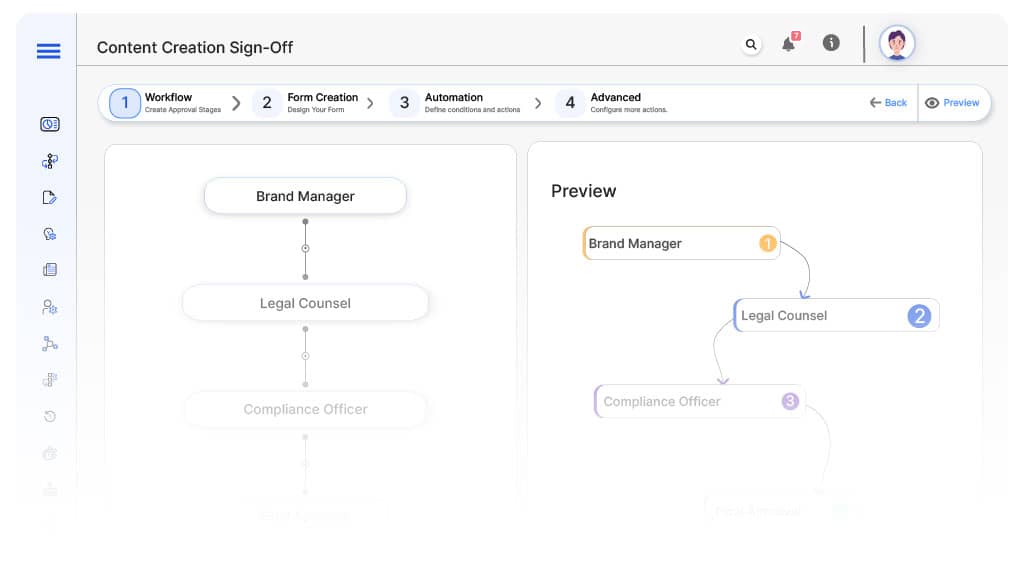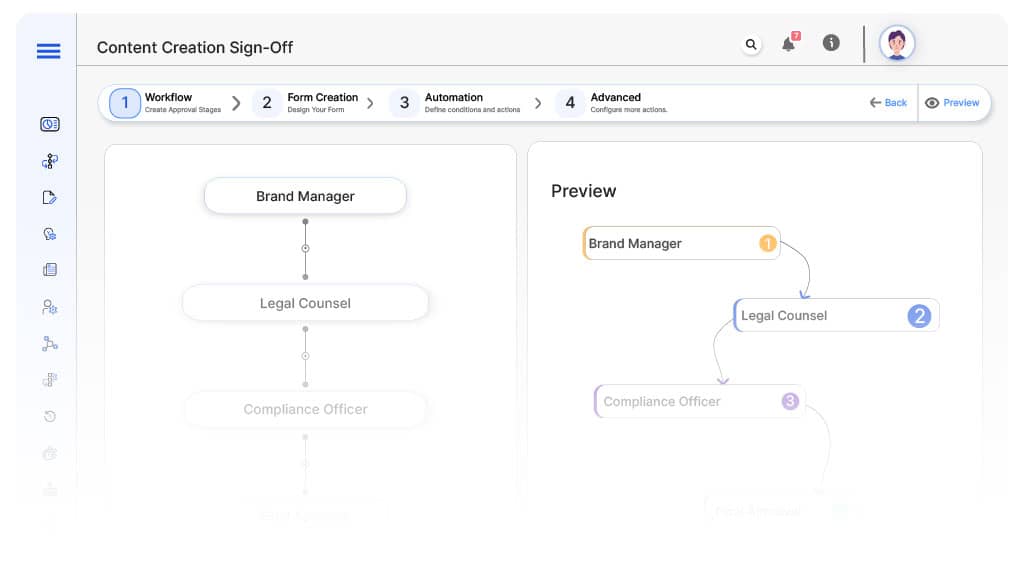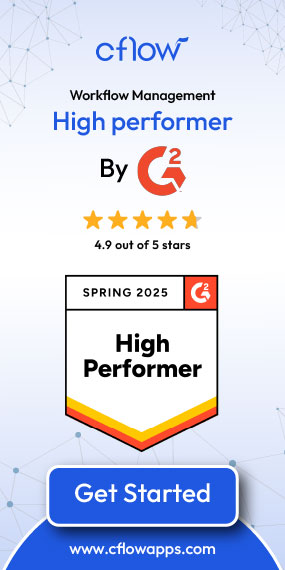- Cflow
- Content Creation Sign-Off Automation
Content Creation Sign-Off Automation

Clow Team

Content creation is at the core of modern marketing, branding, and customer engagement. Without automation, manual content approvals lead to brand inconsistencies, regulatory violations, publication delays, and lost opportunities.
Once content is approved, the next logical step is launching campaigns, which is where Marketing Campaign Approval Automation ensures that only compliant and signed-off content makes it into live campaigns.
Recent industry research shows that 63% of organizations experience content delays due to inefficient review and approval workflows.
Without automation, content creators, marketers, designers, legal reviewers, compliance officers, and brand managers struggle to collaborate, review drafts, manage feedback, and ensure timely publication. This guide walks you through exactly how Cflow automates Content Creation Sign-Off Process, from draft submission to final publishing approval.
What Is Content Creation Sign-Off Process?
The Content Creation Sign-Off Process governs how marketing, sales, social media, advertising, or corporate content is drafted, reviewed, edited, and formally approved before publication across any channel.
Think of content approvals as quality control gates , every piece of content must align with brand guidelines, legal standards, and strategic messaging before release.
Recent industry research shows that automating content sign-off reduces review cycle times by 55% and minimizes compliance issues by 40%.
Just like finance teams depend on Financial Audit Sign-Off Automation for compliance, marketing teams use content sign-off workflows to maintain accountability and traceability.
Why Content Creation Sign-Off Matters for Organizations
Brand Consistency
Regulatory Compliance
Speed-to-Market
Cross-Department Collaboration
Coordinates input from creative, legal, compliance, and leadership teams.
Audit Trail
Maintains full version control and approval logs for governance.
Key Benefits of Automating Content Creation Sign-Off with Cflow
- Centralized Content Submission Portal: Cflow allows content creators to submit drafts with design assets, messaging outlines, and media attachments into a centralized approval workflow.
- Dynamic Routing Based on Content Type: Cflow applies routing logic based on content category (advertising, web copy, social media, legal notices, product marketing, etc.) and regulatory exposure.
- Multi-Level Review Workflows: Submissions route through brand managers, legal counsel, compliance teams, marketing leadership, and executives depending on content sensitivity. Many content projects involve external agencies or freelance creators, making Marketing Vendor Contract Automation crucial for managing agreements tied to content approvals.
- Real-Time Notifications & Escalations: Automated alerts keep reviews on track while escalation rules prevent last-minute publication delays.
- Version Control & Edit Tracking: Cflow retains every content version, tracks edits, comments, and feedback from all reviewers throughout the approval journey.
- Full Audit Trail & Publication Logs: Every review, revision, approval, and publishing authorization is archived for governance and content audit readiness.
- Mobile Accessibility: Reviewers and executives can review, comment, and approve content remotely for fast-moving campaigns.
Get the best value for money with Cflow
User Roles & Permissions
Content Creator (Initiator)
- Responsibilities: Submit content drafts with supporting materials and target audience information.
- Cflow Permission Level: Submit Form.
- Mapping: “Content Team.”
Brand Manager
- Responsibilities: Ensure alignment with brand guidelines, tone, and messaging consistency.
- Cflow Permission Level: Approve/Reject.
- Mapping: “Brand Team.”
Legal Counsel
- Responsibilities: Review content for legal risk, advertising law compliance, and intellectual property concerns.
- Cflow Permission Level: Approve/Reject.
- Mapping: “Legal Group.”
Compliance Officer
- Responsibilities: Validate regulatory compliance, disclaimers, privacy policies, and advertising standards.
- Cflow Permission Level: Approve/Reject.
- Mapping: “Compliance Group.”
CMO / CEO (Final Approver)
- Responsibilities: Provide final sign-off for high-visibility or sensitive campaigns.
- Cflow Permission Level: Approve/Reject.
- Mapping: “Executive Board.”
Discover why teams choose Cflow
Form Design & Field Definitions

Field Label: Content Request ID
- Type: Autonumber
- Auto-Populate: Generated on submission.
Field Label: Content Title
- Type: Text
- Logic/Rules: Mandatory.
Field Label: Content Type
- Type: Dropdown (Social Media, Advertising, Web Copy, Product Marketing, Legal Notice, Internal Communication)
- Logic/Rules: Drives routing.
Field Label: Target Audience
- Type: Text Area
- Logic/Rules: Mandatory.
Field Label: Draft Content Upload
- Type: File Upload
- Logic/Rules: Mandatory.
Field Label: Design Assets Upload
- Type: File Upload
- Logic/Rules: Mandatory.
Field Label: Brand Review Notes
- Type: Text Area
- Logic/Rules: Required for Brand Manager.
Field Label: Legal Review Notes
- Type: Text Area
- Logic/Rules: Required for Legal Counsel.
Field Label: Compliance Review Notes
- Type: Text Area
- Logic/Rules: Required for Compliance Officer.
Field Label: Executive Comments
- Type: Text Area
- Logic/Rules: Required for final approver.
Field Label: Publication Authorization Confirmation
- Type: Checkbox
- Logic/Rules: Marks content fully approved for publishing.
Transform your Workflow with AI fusion
Approval Flow & Routing Logic

Submission → Brand Manager
- Status Name: Pending Marketing Review
- Notification Template: “Hi Marketing Director, new advertising budget request submitted for review.”
- On Approve: Moves to Finance Controller.
- On Reject: Returns to Marketing Manager.
- Escalation: Reminder after 1 day.
Brand → Legal Counsel
- Status Name: Pending Legal Review
- Notification Template: “Hi Legal, content requires legal compliance review.”
- On Approve: Moves to Compliance Officer.
- On Reject: Returns to Brand Manager.
- Escalation: Reminder after 1 day.
Legal → Compliance Officer
- Status Name: Pending Compliance Review
- Notification Template: “Hi Compliance, content requires regulatory and advertising standards validation.”
- On Approve: Moves to CMO/CEO.
- On Reject: Returns to Legal Counsel.
- Escalation: Reminder after 1 day.
Compliance → CMO/CEO
- Status Name: Pending Executive Approval
- Notification Template: “Hi Executive Board, high-visibility content ready for final publishing authorization.”
- On Approve: Moves to Content Authorized.
- On Reject: Returns to Compliance Officer.
- Escalation: Reminder after 1 day.
Final → Content Authorized
- Status Name: Content Fully Approved
- Notification Template: “Content fully authorized; ready for publishing across designated channels.”
Transform your AI-powered approvals
Implementation Steps in Cflow
Create a new workflow
Design the form
Add fields from Form Design & Field Definitions. Apply conditional logic.
Set up User Roles/Groups
Build the process flow diagram
Configure notifications
Set conditional logic
Save and publish workflow
Activate process.
Test with a sample request
Adjust logic if needed
Go live
Example Journey: Product Campaign Sign-Off
FAQ's
Setup typically completes within 5–7 business days.
Absolutely. Cflow integrates with CMS, marketing automation, DAM, and project management platforms.
Unleash the full potential of your AI-powered Workflow

